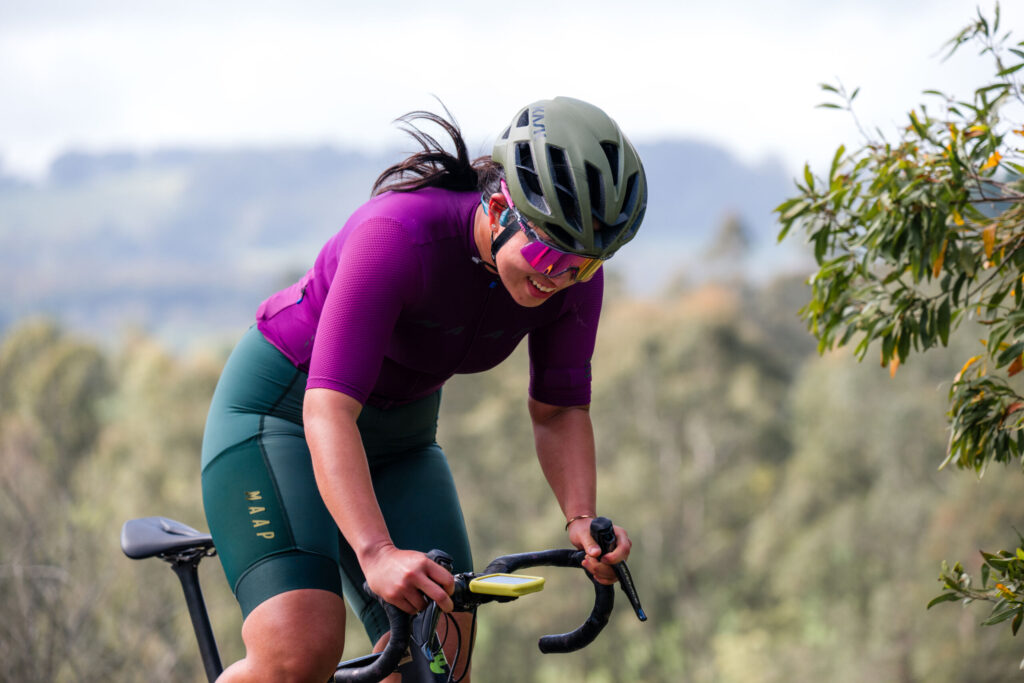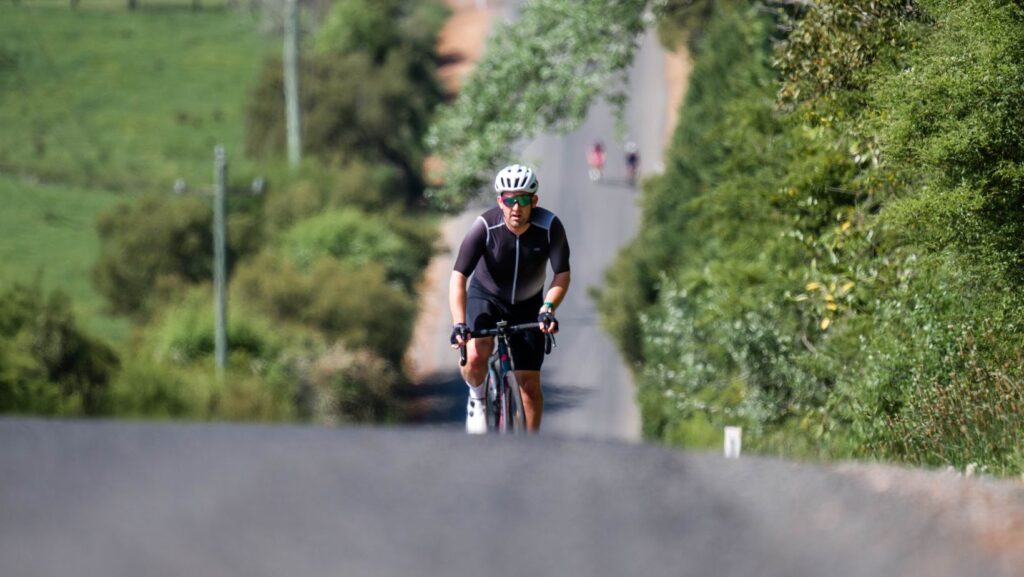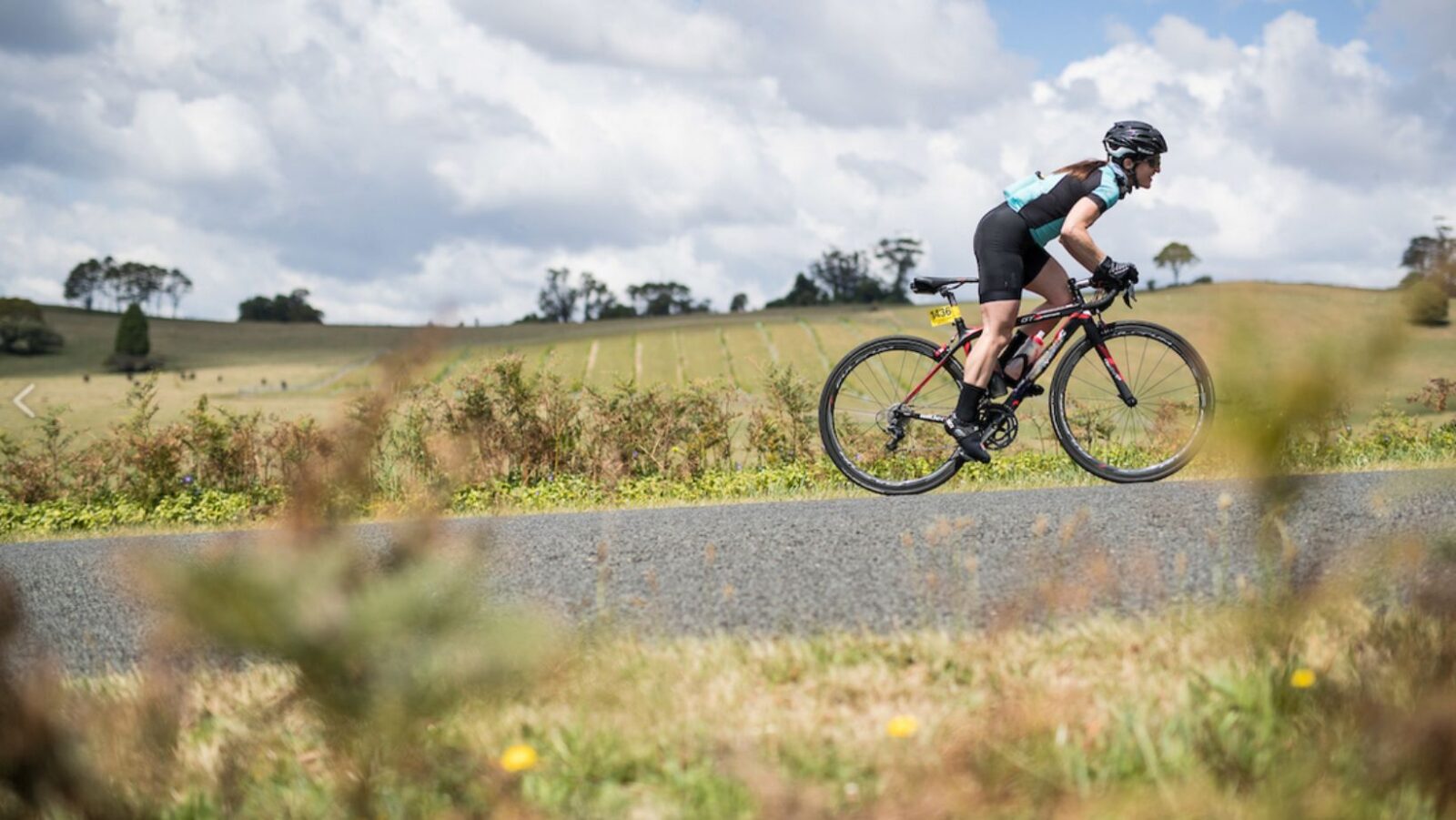Bowral isn’t flat, and that’s exactly what makes it iconic. With less than 8 weeks to go, it’s time to get serious about your hill game. Here are your climbing tips from Geoff Nash of CoLab Coaching.
Training for the Demands of Bowral
One of the fundamental principles of any training programme is that it should replicate the demands of the targeted event. For riders taking on the Bowral Classic there are two main demands. Firstly, you need to be able to complete your chosen distance. So you need good aerobic endurance. The second demand is that you need to be adept at riding uphill.
Why Hills Feel So Tough
Regardless of your level of fitness, riding uphill places different demands on your body that need to be trained. On an incline, gravity pulls you backwards and slows your momentum much faster than on the flat. In order to maintain your momentum, you need to apply more force to the pedals earlier in your pedal stroke.
This results in two things; a slightly different muscle recruitment pattern and a longer time under load with each pedal stroke, especially at lower cadences. If you do not train for this, you are going to be inefficient and prone to fatigue and cramping as your muscles are forced to move for a long period of time in an unfamiliar pattern.

The Obvious Starting Point: Ride More Hills
So what can you do to prepare for this demand? The simple and obvious answer is to ride up hills. Just getting out there and incorporating hills into your training is going to be a big advantage. But there are several additional steps you can take to make your hill training more effective.
My number one tip is to include hill repeats. Turning around at the top of a hill, rolling back down and riding up again is a super effective way to pack more vertical metres into your regular rides. With a course like Bowral, it is also a great way to replicate climbs that come one after the other.
The next step is to focus on how you ride uphill. The key is to be efficient. You should aim to climb like a duck swimming. Below the waist, it’s all about forward propulsion. Above the waist, you should be calm and relaxed. Your hips should be still and planted and your upper body should be quiet.
When pressing hard on the pedals, it’s easy to transfer tension into your arms and upper body. This is a waste of energy and stifles your breathing. Rest your hands on your handlebars, don’t choke them. Make sure your shoulders aren’t around your ears!
Aerodynamics is less important at lower speed and it is often more beneficial when climbing to sit up, relax your upper body and open up your chest in order to breathe more easily. Relaxing your upper body will save you a couple of heart beats for the same output which can be the difference between sustaining your power or tipping over the edge.
Momentum Is Everything
With so many ups and downs on the Bowral Classic course, climbing efficiently and transitioning from one climb to the next becomes super important. If I could sum this up in one sentence it would be “momentum is your friend”.
Over a lumpy course like Bowral, being able to carry your speed over each climb and onto the next can add up to huge savings of energy and time. Sadly, so many riders come to the crest of a hill having done 99% of the hard work, only to ease up and lose momentum.
Don’t do this. Instead, keep pedalling a few extra metres over the crest and down the other side. You don’t have to pedal hard, just maintain your pace until gravity takes over. Now you can freewheel and recover at speed. Think about every hill ending over the crest and not at the top, and incorporate this technique into your training.
Sit or Stand? Both!
Should you sit or stand? There is no right or wrong answer. Standing up when you climb allows you to drop your body weight through the pedals to create more power and I encourage you to practice doing this.
However, your bodyweight is no longer supported by your saddle, so there is a greater metabolic cost to climbing out of the saddle. Yes you can generate more power, but you will also increase your heart rate and use more energy than staying seated.
My advice is to climb out of the saddle in short efforts. Use it to get through particularly steep sections or to mix things up briefly on a long climb. Practice standing up smoothly and maintaining your rhythm and momentum.
Be aware that many less experienced riders will pull their bike back toward them when changing from a seated to a standing position. Don’t do this. If you are riding uphill in a close group, you risk pushing your back wheel into the rider behind you, bringing them or the both of you down. Conversely, if you find yourself in a tight group on a climb, allow a little room to the rider in front just in case.
What About Cadence?
First of all there is no perfect cadence and I encourage my athletes to be comfortable pedalling at a broad range of cadences.
Typically, your cadence is going to be slower riding uphill. However, modern day gearing is much broader and eliminates the need to grind away on all but the steepest of hills.
Pedalling at lower rpm means for every pedal stroke your legs are under load for longer. Power is also a multiple of Force x Cadence. So as cadence drops, force must increase to maintain the same power.
So where possible, I would suggest using the lowest gear that allows you to maintain a relatively normal cadence. In other words, change down and spin rather than use more force. Of course the more aerobically fit you are, the more you are able to spin and not muscle your way up a climb. I refer to this as “lungs over legs”.
If you include a variety of hills in your training, you will naturally need to pedal at lower cadences. If you include hill repeats, you will increase your overall time under load. This should be enough. I don’t recommend deliberately riding uphill at 40 rpm. The injury risk v reward for most people is simply not worth it.

Train Smart With Power
If you ride with a power meter and know your FTP, you are at an advantage. Fast Twitch (Type II) muscle fibres start to play a significant role around FTP. Fast Twitch fibres are strong, but are more prone to fatigue. By climbing at a power output slightly below (around 85 – 90% of your FTP) you can significantly extend your time to exhaustion while still maintaining good speed.
Strength Training Helps Too
There is overwhelming evidence that undertaking resistance training can have a huge positive benefit for endurance athletes.
Primarily, increased muscle strength gained by resistance training can greatly increase time to exhaustion. There are lots of additional benefits like increased bone density and lean muscle mass, but if you want to be better at riding up hills, getting to the gym is a great option.
Even if you don’t have access to a gym, basic body weight exercises like squats, lunges, step ups, Bulgarian lunges (split squats) and push ups can be done at home with little to no equipment. One or two simple sessions a week will have you feeling stronger and climbing better.
Don’t Forget the Mental Game
Finally, you need to be mentally prepared. Like a true one day classic course, the Bowral Classic has a jagged, sawtooth profile with multiple hills and very little respite. This makes it hard to find your rhythm and measure your effort.
When you are fatigued and each hill is followed by another, maintaining a positive mindset is difficult. But that’s what makes completing the event so rewarding. Like your legs and your lungs, your attitude can be trained.
Practice climbing with a positive mindset until it becomes your default mode. Embrace riding uphill instead of approaching it with dread. Regardless of your fitness, every hill is an opportunity to celebrate your capabilities.
October 19th incoming. Sign up now.
